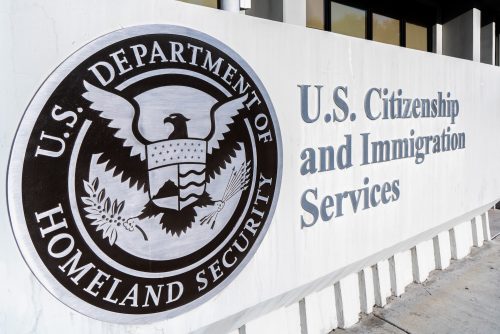Many people assume that their family immigrated to the United States legally, or did it “the right way.” In most cases, this statement does not reflect the fact that the U.S. immigration system was very different in the past and that their families might not have been allowed to enter had today’s laws been in effect. When many families arrived in the United States, there were no numerical limitations on immigration, no requirements to have an existing family or employment relationship with someone in the country, and no requirement to obtain a visa prior to arriving. The definition of who is “legal”—and who is not—changes with the evolution of immigration laws. In some cases, claiming that a family came “legally” is simply inaccurate—unauthorized immigration has been a reality for generations.
Many of our ancestors would not have qualified under today’s immigration laws.
Today’s laws require that potential immigrants be closely related to qualified U.S. citizens or permanent residents, have employment offers from U.S. employers, or qualify as refugees. Today’s laws would have effectively restricted many of our families from coming legally to the United States.
Until the late 19th century, there was very little federal regulation of immigration—there were virtually no laws to break.
A growing, increasingly industrialized nation needed workers, and immigration was “encouraged and virtually unfettered.” Potential immigrants did not have to obtain visas at U.S. consulates before entering the country. Rather, immigrants would simply arrive at ports of entry (such as Ellis Island), where they were inspected and allowed into the country, unless they fell into one of the excluded categories discussed below.
Before the 20th century, there was virtually no bureaucracy responsible for enforcing immigration laws.
U.S. land borders were once largely unguarded, and people in the United States without legal status were unlikely to be caught or deported since very little money was appropriated for immigration enforcement and deportation. In 1882, the first general immigration law was enacted, creating the first immigration bureaucracy, to be supervised by the Secretary of the Treasury. The Immigration Act of 1891 established a Bureau of Immigration in the Treasury Department. The Immigration Act of 1924 (the Johnson-Reed Act) finally set up the first “consular control system,” which required that visas be obtained abroad from a U.S. consulate before admission. The 1924 law also established the Border Patrol since restrictive laws had led to large numbers of unauthorized immigrants entering the country.
Prior to the 1920s, there were no numerical limitations on immigration to the United States, but certain persons were banned from entering.
Dating back to the late 1800s, the United States began banning certain groups or categories of individuals from entering the country. For example, the Chinese Exclusion Act, passed in 1882, restricted Chinese workers from immigrating and was not repealed until 1943. Other laws barred additional groups from lawfully immigrating, including most Asians (except Japanese and Filipinos), prostitutes, paupers, polygamists, persons with “dangerous and loathsome contagious disease,” persons likely to become a public charge, anarchists and radicals, the “feebleminded” and “insane,” and the illiterate. Of course, some people lied about their health and political beliefs and entered unlawfully. The vast majority of people who arrived at a port of entry were allowed to enter; the Immigration Service excluded only 1 percent of the 25 million immigrants from Europe who arrived at Ellis Island between 1880 and World War I.
The first numerical caps on immigration and limitations on Europeans were not established until the 1920s—after the great wave of immigration to the United States.
The Quota Law of 1921 and the Immigration Act of 1924 created a quota system that was based on race and nationality. These laws heavily favored Western European immigrants, while closing the door to “undesirables,” including people from Southern and Eastern European countries. The 1921 and 1924 laws did not put numerical limits on natives of the Western Hemisphere, including Canada, Mexico, and South America. However, head taxes (fixed fees charged to each person entering) and literacy tests kept many from obtaining visas. For the first time, the 1924 law required immigrants to present medical certificates to the U.S. consul abroad and obtain a visa prior to arriving in the United States.
Every restriction generated unauthorized immigration.
As laws were passed to keep out Asians and Eastern and Southern Europeans, immigrants from those countries—as well as others who could not pass literacy tests, pay the head tax, or enter through the quota system—began to enter outside of the legal system. In 1925, the Immigration Service reported 1.4 million immigrants living in the country illegally. A June 17, 1923, New York Times article reported that W. H. Husband, Commissioner General of Immigration, had been trying for two years “to stem the flow of immigrants from central and southern Europe, Africa and Asia that has been leaking across the borders of Mexico and Canada and through the ports of the east and west coasts.” A September 16, 1927, New York Times article describes government plans for stepped-up Coast Guard patrols because thousands of Chinese, Japanese, Greeks, Russians, and Italians were landing in Cuba and then hiring smugglers to take them to the United States. Many immigrants were also violating the laws of their home countries, which required them to get permission to migrate, complete military service, or pay off debts prior to leaving.
Many European immigrants benefited from “amnesties.”
Acknowledging the large numbers of Europeans in the United States without proper authorization, the government devised ways for them to remain in the country legally. The 1929 Registry Act allowed “honest law-abiding alien[s] who may be in the country under some merely technical irregularity” to register as permanent residents for a fee of $20 if they could prove they had lived in the country since 1921 and were of “good moral character.” Roughly 115,000 immigrants registered between 1930 and 1940—80% were European or Canadian. Between 1925 and 1965, 200,000 unauthorized Europeans legalized their status through the Registry Act, through “pre-examination”—a process that allowed them to leave the United States voluntarily and re-enter legally with a visa (a “touch-back” program), or through discretionary rules that allowed immigration officials to suspend deportations in “meritorious” cases. In the 1940s and 1950s, several thousand deportations a year were suspended; approximately 73% of those who benefitted were Europeans (mostly Germans and Italians).
Conclusion
Unauthorized immigrants have existed throughout U.S. history. Depending on the laws at the time, different groups have been subject to barriers making it difficult for them to arrive through the legal immigration system. Today’s laws would have excluded many Americans and their ancestors.




